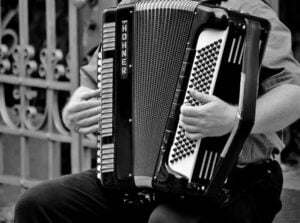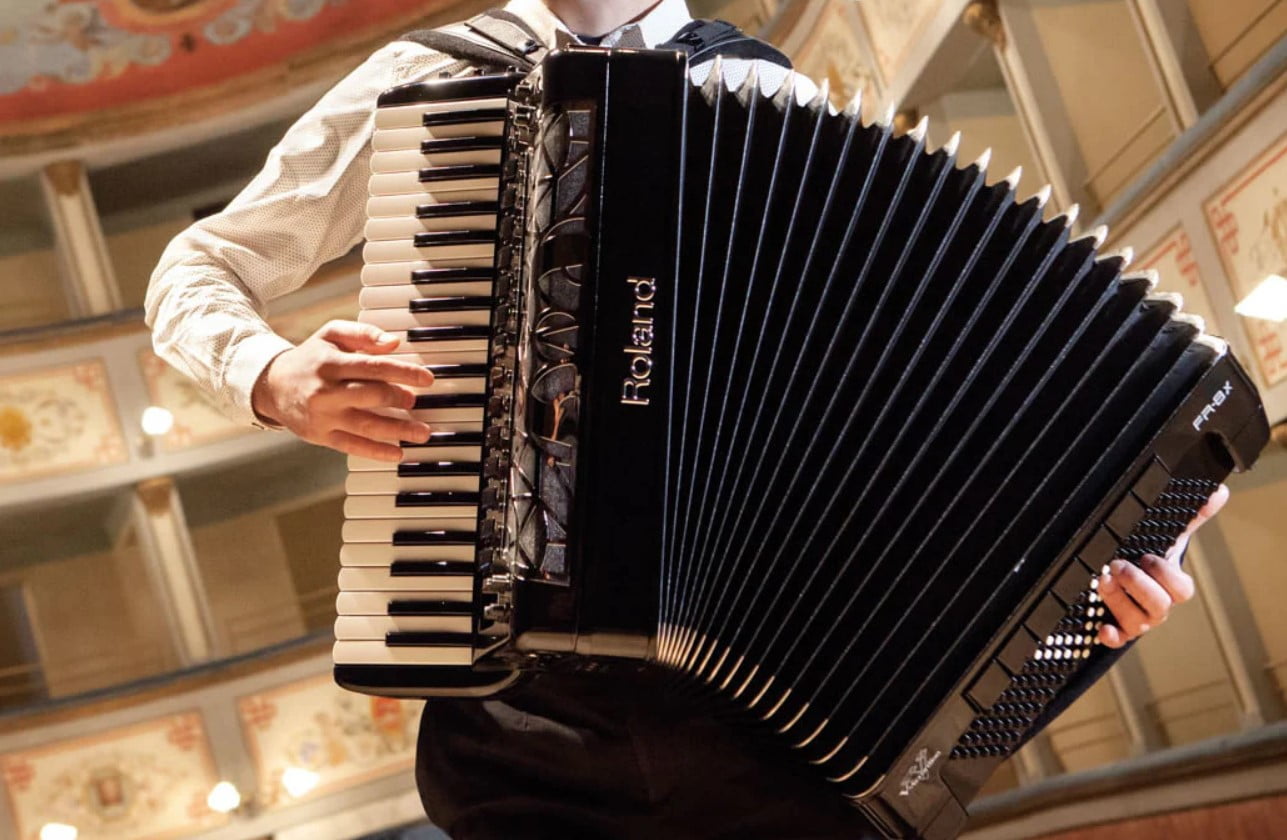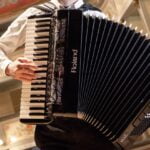The accordion, a unique instrument belonging to the bellows-driven free reed aerophones family, is characterized by its box-like shape. It integrates a melody section on the right-hand keyboard with accompaniment or basso continuo functionality on the left-hand side. Players produce melodies using the buttons or keys on the right, while the left hand manages bass notes or pre-set chords.
First invented in the early 19th century, the accordion has found a place in a myriad of music genres, ranging from folk to heavy metal. It shares similarities with other free-reed instruments such as the harmonica, concertina, and harmonium. There are various styles of accordions, each tailored to different musical traditions. Folk and ethnic music often favor the button-style keyboard, featuring diatonic scale buttons on the right and left-hand buttons for bass notes and major and minor triads.
The accordion’s origin is a topic of scholarly debate. Some attribute its invention to C. Friedrich L. Buschmann, who patented the Handoline in Berlin in 1822. Others credit Cyril Demian of Vienna, who patented his version in 1829 and coined the name “accordion.” Demian’s design was an enhancement of the Handoline, featuring small manual bellows and five keys, with the potential for additional keys.
Beyond its musical applications, the accordion has made appearances in popular culture. For instance, Marvel Comics honored the late rapper MF DOOM by incorporating lyrics from his song “Accordion” into a recent comic.
History of Accordion

- Origins of the Accordion: People often credit Christian Friedrich Ludwig Buschmann, a German instrument maker, with inventing the modern accordion in 1822. The accordion’s roots trace back to various European countries, including Germany, Austria, and Italy, during the early 19th century. It is believed to have evolved from earlier instruments like the Chinese sheng and the harmonica.
- Early Development: After its invention, the accordion quickly gained popularity among folk musicians and street performers. Its portable nature, combined with its ability to produce a full range of musical tones, made it an ideal instrument for solo performances and accompaniment. The early versions of the accordion featured a limited number of buttons and a simple bellows system.
- Industrial Revolution and Technological Advancements: The Industrial Revolution in the 19th century brought significant advancements in the production of accordions. The introduction of mass production techniques and the improvement of materials and construction methods led to the creation of more durable and reliable instruments. The accordion underwent several modifications, including the addition of more buttons, keyboards, and a more efficient bellows system.
- Accordion’s Cultural Impact: The accordion’s versatility and expressive capabilities allowed it to become an integral part of various musical genres worldwide. In Europe, it found its place in folk music traditions, particularly in countries like France, Ireland, and Poland. It also played a significant role in popularizing tango music in Argentina during the early 20th century, thanks to musicians like Astor Piazzolla.
- Popular in Music: During the mid-20th century, the accordion found its way into popular music genres like jazz, rock, and even country. Artists like Fats Domino, The Beatles, and Weird Al Yankovic incorporated the accordion into their music, adding a unique flavor to their compositions. Today, contemporary musicians continue to experiment with the accordion, pushing its boundaries and exploring new musical possibilities.
- Accordion’s Global Presence: The accordion’s popularity spread far beyond Europe and the Americas. It made its way into diverse cultures, including Russia, China, and India. Additionally, Each region adapted the instrument to suit their traditional music, resulting in distinct playing techniques and styles.
Types of Accordion
Accordions come in a variety of types, each with unique features tailored to different musical styles. Here are some of the most common types of accordions:

Diatonic Accordions: Accordion manufacturers produce numerous variations of these instruments, and musicians frequently use them in folk and ethnic music. Diatonic accordions can have one or multiple rows of buttons. Moreover, They produce different notes when pushing or pulling the bellows, a characteristic known as being bosonic.
Chromatic Accordions: Chromatic accordions are divided into two main types: piano accordions and button accordions. Piano accordions feature a piano-style keyboard on the right-hand side, while button accordions use buttons for the treble notes. These accordions are prevalent in a variety of music genres and are particularly common in mainland Europe and Russia.
Concertinas: Concertinas are small, hand-held accordions that stand out from other types. They are often linked with traveling musicians and are popular among sailors. Concertinas come in various systems, including Anglo, English, Duet, and German concertinas.
Digital Accordions: These modern accordions incorporate electronics and may not always have free reeds. Furthermore, Digital accordions offer additional features and capabilities beyond those of traditional accordions.
Piano Accordions: Recognized as the most popular type in the Western world, piano accordions have a piano-style keyboard on the right-hand side. Furthermore, They are highly versatile and can be used to play a wide range of music genres. Piano accordions can also feature different bass systems, such as Stradella, French 3-3, or Free Bass.
Read Also
Facts About Hands | The Art of Hand-Eye Coordination
Timberwolves’ Historic Game 6 Win: Nuggets Seek Solutions
29 Fascinating Facts About Ecuador
Fun Facts About Accordion
The accordion, with its unique sound and distinct appearance, has a rich history and some fascinating facts associated with it. Here are some fun and interesting facts about the accordion:
- Invention and Development: Christian Friedrich Ludwig Buschmann, a German instrument maker, invented the accordion in the early 19th century. However, some debate the exact inventor, also crediting Cyril Demian of Vienna with the accordion’s invention.
- Components of an Accordion: An accordion consists of three main parts: the right side, which contains the keyboard or buttons. Moreover, The bellows in the middle function as a bow, and the left side, houses the bass buttons.
- Global Popularity: The accordion has gained popularity worldwide and has found its place in various cultures and musical genres. Furthermore, It has a particularly long history in Africa, where it arrived in the 19th century through European and West African sailors, merchants, and settlers.
- Versatile Instrument: The accordion’s versatility is well-known. Moreover, players can use it in a wide range of musical genres, including folk, tango, jazz, rock, and even classical music. Its expressive capabilities and ability to produce a full range of musical tones make it a versatile instrument.
- Different Sizes: Accordions come in various sizes, categorized by the number of bass buttons. Common sizes include 12 bass, 48 bass, 72 bass, and 120 bass accordions. However, The number of bass buttons determines the range and complexity of the instrument.
- Expensive Accordions: The most expensive accordion in the world is the Pigini Mythos accordion, valued at around $40,000. It is known for its deep, velvety, and rich tones.
- Accordion’s Association with Other Instruments: The accordion is associated with the Chinese musical instrument called the Sheng, which shares similar principles of operation. Additionally, The Sheng, with its bamboo pipes and wind chamber, served as a prototype for the development of the accordion.
- Accordion’s Handmade Nature: The manufacturing process of accordions involves a significant amount of hand assembly. While there are some automated processes, the intricate nature of the instrument requires manual assembly of many small parts, making each accordion somewhat unique and handmade.
- Accordion in Carnegie Hall: On April 18, 1939, Joe Biviano, Abe Goldman, and Gene von Halberg became the first people in history to play the accordion in Carnegie Hall. Also, They performed Bach’s music on this iconic stage.
Final Thoughts
The accordion’s journey through history is a testament to its enduring appeal. From its humble beginnings to its widespread use in various musical genres, the accordion has remained a symbol of cultural expression and musical creativity. Whether it is played in concert halls, on street corners, or at family gatherings, this remarkable instrument continues to captivate audiences worldwide.










